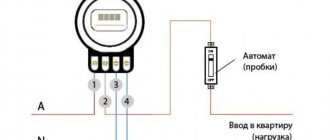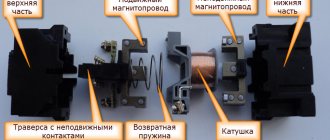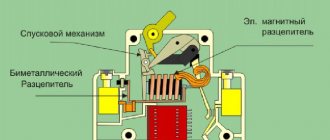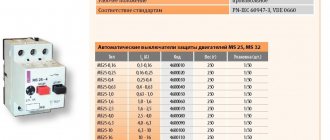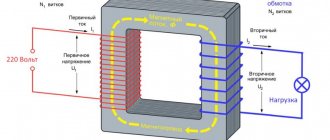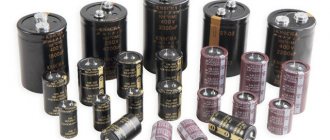Terminals with spring contacts are an invention of the German manufacturer Wago. The first model appeared in 1951. Since then, the company has significantly improved the design. Wago now offers small terminals for junction boxes. Soldered versions have been produced since 1973. Like any other method of connecting conductors, spring clamps have their pros and cons. They will be discussed in more detail below.
What is inside. Device
Using an example of a real connection, let's look at what happens inside the “disposable” terminal block Wago 773. I snatched this terminal block from the junction box because it was not needed.
Terminal block Vago 773 with inserted wires 1
Do not pay attention to the burnt wire, it is due to thermal injury from the previous connection. Remove the transparent protective cover:
Vago terminal block with inserted wires. Device.
You can see how tightly the wires fit, the sharp edge bites the wire, and the flat edge provides the contact area.
Terminal block Vago 773 with inserted wires 3
This photo shows how the copper wire is bitten. You can remove the wires from such a clamp only by unscrewing them and using force.
Terminal block Vago 773 with inserted wires 4
This contact was used as a contact in the lighting circuit.
But this is what happens when VAGs are used with old wires in the power circuit of an apartment:
Terminal block Vago 773 burnt out 1
Through Wago 773-304, 2 old aluminum wires and 1 new copper wire were connected to 4 clamps with paste. Everything would be fine, especially considering that the circuit is limited to a 16A machine. However, the terminal block burned out:
Vago terminal block burned out
It burned because the aluminum that was inserted into the connector was old, and the old burnt area had to be cut off and cleaned as much as possible before connecting. So this is what happened:
The Vago terminal block burned out along with the wires
More detailed examples of using Vago terminals in electrical installations are given in a separate article. See in what difficult situations these terminal blocks help out.
Models of Wago spring terminals
The products of the German manufacturer are used to create temporary electrical circuits. For example, at construction sites or when upgrading the network. Clamps are either disposable or reusable. The latter are called lever ones. General characteristics:
- cross-section - from 0.08 to 4 square millimeters;
- current strength - from 20 to 32 amperes.
The most popular Wago series are listed below.
Push Wire
Flat spring terminals, 773 series. Outdated design, early to market.
Used in copper-aluminum connections. Suitable for wires with one core or several non-flexible ones. It is not possible to install a flexible conductor into a spring. The only way is to twist it and then tin it. For this you need a soldering iron. The spring is wedge-shaped, this makes it easier to install the wire. It is difficult to remove the contacts back without damaging them. Therefore, the 773 series products are called disposable.
The stripped wires inside lie on a curved core. The straight end of the conductor improves the quality of contact. The insulation can be removed with a knife, but it is better to use a stripper. The latter eliminates the occurrence of cuts, which subsequently break off, and keeps all the cores intact.
The clamp family includes two sub-series:
- 773-30x . The housing does not allow light to pass through. On contacting surfaces there is a lubricant made of Vaseline with an admixture of quartz. It prevents aluminum contacts from oxidizing. Before connecting, you need to clean the oxidized ends of the wires again.
- 773-32x. The body is made of transparent plastic. The operating principle is the same. There is no quartz vaseline lubricant. It is convenient to control the introduction and fastening of contacts. Oxidized wires must be cleaned.
Characteristics of the 773 series:
- length - 19.5 millimeters;
- width - 13 millimeters (4 wires);
- height - 13.1 millimeters;
- current strength - up to 24 amperes;
- voltage - up to 380–600 volts;
- discharge voltage - up to 4 kilovolts;
- operating temperature - up to 85°C;
- There is a window for a voltmeter probe 6 millimeters deep.
The product is suitable for home network equipment, including sockets and lighting circuits. When connecting devices with a power over 5 kilowatts, other connection options are used.
To connect to the terminal, you need to remove up to 12 millimeters of insulation from the wire. The contact is inserted inside and securely latched with a spring. It will not be possible to remove it back without compromising its integrity.
Cage Clamp
Reusable terminals from Wago.
Carabiner springs and modernized locks are used in production. When pressure is applied, the clamp moves sideways and makes contact. You can remove the wire by pressing the spring again. This allows you to insert hard, soft, stranded conductors. Pressure is applied from top to bottom. The most popular version of such a terminal is the 222 series. To connect, you need to strip the ends by 8–10 millimeters. The contact is inserted all the way with the clamp clamped. After installation, just release the spring, it will automatically fix the wire. There is no need to tin, twist or use ferrules.
Characteristics of 222 series terminals:
- opaque body;
- contact cross-section - from 0.08 to 4 square millimeters;
- current strength - up to 32 amperes;
- there is a window for a multimeter probe or voltage indicator;
- length - 20.5 millimeters;
- width - 12.4 millimeters;
- height - 12.5 millimeters.
The products are perfect for mounting a chandelier. To then remove it, you do not need to cut the wire and remove the insulation. Just press the spring and remove the contacts. Installation is carried out without damaging the walls and ceiling.
Spring terminals of the 221 series are smaller in size. They are made in a transparent case. This makes it possible to control the quality of the contact connections. Device width:
- 13.1 millimeters (two-wire);
- 18.7 millimeters (three-wire);
- 29.9 millimeters (five-wire).
The Wago 224 series is designed for connecting lighting equipment. The contacts are connected end-to-end. The wire does not have to be bent, reducing its service life. Instead of this series, you can use other reusable ones for mounting chandeliers and sconces.
DIN rail terminals
Used to create complex circuits. Suitable for use in electrical panels. There are several series of spring terminals, with and without fuses. Disconnectors and light indicators using diodes can be installed in the network.
Examples of using Vago terminals in practice
There are several articles on the Sam Electric website that also show the practical use of Wago terminals. For example (in new tabs):
Installation of spotlights
Installation and connection of the chandelier
Installation of a chandelier on a suspended ceiling
Installation of sconces (wall lamp)
There will be other articles; in modern electrical installations, Vago terminals are used very widely.
And if you are at all interested in what I write about, subscribe to receive new articles and join the group on VK!
Security issue
The safety of connecting wires using spring terminals is still in doubt.
Their reason is the different geometry of the round wire and the flat busbar. The result is a point-to-point interaction that is not reliable enough. Screw terminals ensure full element contact. The same goes for sleeves and terminal blocks. At the same time, Wago clamps allow you to use soft conductors with one or more cores when assembling a circuit. The strength of the spring fixation is not affected by either the geometry or the number of wires in the cable. In addition, when dismantling a reusable connection, there is no need to cut the wires and damage the integrity of the fastening surfaces.
Wago terminals have been heat tested. They are not prohibited by the PUE and are fully suitable for creating a household network. The manufacturer has international certificates. The declared parameters of current and voltage are confirmed during tests. The body is insulated - no need to create a winding of electrical tape.
When using spring terminals:
- comply with the maximum parameters set by Wago - no more than 32 amperes and 600 volts;
- use a quartz vaseline composition that prevents contact oxidation - if it is not already applied by the manufacturer;
- for soft conductors - first make a rigid twist, scald or tin the ends.
Failure to comply with these rules will lead to deformation and overheating of the terminal and conductors. This will result in a short circuit and fire. Before installation, please read the terms of use.
Terminals for lighting equipment
WAGO lighting terminals provide ideal connections between solid and fine stranded conductors. Thanks to certification as independent equipment according to EN 60998, WAGO lighting connectors can be used in virtually all electrical connections between solid and fine stranded conductors in the home and building services.
- Ideal connection of solid conductors with thin stranded conductors.
- Easy wiring installation without tools - especially convenient when working at heights
- Suitable for a wide range of applications, including connecting devices with flexible conductors to fixed installations (eg curtain motors).
Is it possible to connect cables by twisting?
According to the rules of the PUE, twisting is prohibited, as it does not provide reliable contact. It can only be used in conjunction with another connection method. It is also unacceptable to use twisting to join two different metals.
Stranded and single-core
When connecting multi-core wires, the following rules should be followed:
- strip the insulation by 4 cm;
- unwind the conductors by 2 cm;
- connect to the junction of untwisted conductors;
- twist the wires only with your fingers;
- You can tighten the twist using pliers;
- bare wires are insulated with special tape or heat shrink tubing.
Twisting solid wires is much easier. They need to be stripped of insulation, twisted by hand along the entire length, then clamped with pliers and insulated.
Twisting methods
You can do twisting in different ways. It can be made by branch, parallel or series connection. Also, to improve the reliability of contact, caps and clamps are additionally used.
Correct twisting of electrical wiring in a junction box
When twisting, you need to follow the following procedure:
- cut off power to a house or apartment;
- clear the wiring of 4 cm or more of insulation;
- unwind the wires by 2 cm;
- connect untwisted wires to the junction;
- twist the veins with your fingers;
- tighten the twist with pliers;
- insulate exposed wires.
Both single-core and multi-core cables can be connected.
Twisting of different sections
Do not twist wires with very different diameters. Such contact is not reliable and stable. You can twist wires of adjacent sections - for example, 4 sq. mm and 2.5 sq. mm. When twisting, you need to make sure that both wires wrap around each other. A thin wire should not be wound onto a thick one, otherwise the contact will be unreliable. Then you need to solder or weld the joint.
Twist caps
The caps help to reliably insulate the contact point. The cap is made of fire-resistant material, inside it there is a metal part with threads.
Making twists using caps is quite simple - you need to remove 2 cm of insulation and lightly twist the wires. A cap is put on them and turned several times until the metal wires are inside.
With terminal clamps
The contact clamp consists of a screw, a spring washer, a base, a current-carrying core and a stop that limits the spreading of the aluminum conductor. Making a connection using a contact clamp is simple - just strip the ends of the wires by 12 mm and insert them into the hole in the clamp. Contact clamps are used for both solid and stranded conductors.
After twisting, the wires need to be soldered. To do this, the wires are tinned and rosin is applied to them before twisting. The heated soldering iron is lowered into the rosin; it needs to be passed along the stripped part of the wiring. After twisting, take tin on a soldering iron and heat the joint until tin begins to flow between the turns. This method takes a lot of time, but it is reliable and of high quality.
Features of application and installation of Wago
- If the loads and operating conditions provided for by the design exceed those indicated in the table, the Vago cannot be used.
- For cables with an aluminum core, use only Wago clamps filled with special paste. The paste removes the layer of existing oxide and prevents its appearance in the future. Without this mixture, the contact point will begin to overheat over time, which will lead to the destruction of the conductor.
Installation of Wago terminal blocks.
Advantages of Vago terminal blocks
In essence, the described terminal is a flat-spring type clamp, but after modification by specialists it received the following advantages.
- A separate clamp is provided for each cable.
- The dimensions of the terminal blocks are very compact.
- Thanks to the high quality of the connection, the likelihood of inaccurate installation due to the “human factor” is completely eliminated.
- Current-carrying elements are perfectly protected from accidental touches.
- During operation, the conductors are not damaged or deformed.
But the main advantage is increased safety and reliability. After all, if, for example, hidden wiring is installed in the ceiling, then you want to be sure that it will not short out, burn out inside the terminal block, or cause other troubles. But, despite such reliability, all terminal blocks described provide for the possibility of control and access.
PUSH WIRE® Connectors for Junction Boxes
Our products support wide cross-sections: MICRO PUSH WIRE® Series 243 connectors are specially designed for small diameters (eg in low voltage installations). Series 2273 products can be used to terminate solid conductors up to 2.5 mm2 (14 AWG); 773 Series products accept connectors up to 4/6 mm2 (12/10 AWG).
- Compact dimensions
- Fast wiring due to simple insertion of solid conductors
- Connecting conductors without tools
- Thanks to the locking holder, it is ideal for use in switchgear applications
- Reusable
- Transparent housing allows you to verify that the conductor is inserted correctly
Universal connection terminals for all types of copper conductors
From intercom system wiring to electric ovens, various types of conductors can be connected quickly and easily using WAGO 221 Series compact connection terminals.
- Connect conductors of any type without prior preparation
- Combine conductors of any types and sizes
- Easy to use operating lever for contactless connection
- Ability to carry high currents up to 32 A
- Thanks to the locking holder, it is ideal for use in switchgear applications
Terminal blocks for DIN rail
This includes a very large family of different terminals designed for permanent installation in electrical panels on a standard DIN rail. They are distinguished by an ultra-narrow profile and can have grounding, a fuse, a circuit breaker, an LED indicator, as well as clamps of various designs.
As a rule, they are unlockable - either Cage Clump or Fit Clump: this is done with the aim, on the one hand, to increase the speed of installation work, and on the other hand, to facilitate possible future repairs.
Examples of series with a Fit Clump that cuts through the insulation - 280, 285, 290.
Errors when connecting wires and cables
Mistake #1. Selecting a cable brand. For each type of room, a cable is used that meets all safety requirements and the intended purpose of the electrical equipment.
Mistake #2. The choice of wire cross-section size is smaller than required. The choice of cable is made taking into account the technical parameters:
- rated current value;
- possible circuit losses;
- calculation of the influence of losses on the design features of the electrical circuit.
It would be wrong to simply look at the tabular data of the standards. They indicate the parameters for ideal working conditions
It is important to take into account the temperature of a particular room, humidity, etc. It is not recommended to use copper wires with a cross-section of 1.5-2.0 mm2 and current values of 10-15 A
Mistake #3. There is no access to the contact cores of the conductors. When planning work with electrical equipment, you need to consider the accessibility of all working contacts. This situation occurs in office premises, where controlled boxes violate the interior concept and are placed in an inaccessible place.
Mistake #4. Poor contact of wires. This error is the most dangerous from a fire safety point of view. For connections, modifications to terminals, clamps, or welding or crimping are used. It is prohibited to use twisted wires as connections.
Mistake #5. Violation of the rules for using terminals. The connection of the WAGO terminal is carried out correctly only under the conditions of correct use of the specific model. Failure to comply leads to damage to the fasteners themselves, as well as to the contact conductors and, consequently, the operation of the system is disrupted.
WAGO connectors - series differences
WAGO terminal blocks are produced in series that correspond to the first three digits of their article number. Each series of connectors not only has a different appearance, but also different technical characteristics.
The technical characteristics of the connectors should not be underestimated. Any connector connects electrical wires through which electric current flows. The connection of wires is the most vulnerable section of electrical wiring. Poor contact leads to sparking and heating of the wires, and as a result, electrical wiring malfunction or fire.
WAGO connectors provide reliable connection of wire cores. WAGO technology does not use a screw connection. The wires are secured under spring plates (773 series) or pressed with a flat clamp (222 series).
Let's look at the series of WAGO connectors sold.
Pricing:
Obviously the weakest (if not the only) point of German terminals is their rather high price. The table below shows the average results for the Russian electrical market for small wholesale.
| model | Wago terminals (Germany) | Feble terminals (China) |
| 222-412 (2 contacts) | 15 rub. per piece | 7.2 |
| 222-413 (3 contacts) | 19 rub. per piece | 11.08 |
| 222-415 (5 contacts) | 45 rub. per piece | 20.54 |
According to As of July 5, 2016 (at the exchange rate of $US according to the Central Bank - 64.55 rubles)
German terminals are 2-2.5 times more expensive than their Chinese counterparts; the more contacts, the larger the gap. This is due to several reasons:
- The popularity and “value” of the Wago brand is much higher compared to the little-known Chinese Feble.
- Wago’s package of certificates is much larger; it includes not only mandatory laboratory tests, but also voluntary ones, and according to the standards of the various countries where their products are presented. The Chinese manufacturer limited itself to only mandatory tests (UL, EAC, VDE, CVC).
- Service and support. Wago has a wide network of official distributors around the world and its own service centers. Chinese Feble has few representatives, but replacement of defective parts is included in the after-sales service of this manufacturer
How to carry out work in water and land
During electrical installation work, a situation often occurs when it is necessary to fasten electrical wiring under water or in the ground. Now we will briefly look at the features of each case!
In water (for example, when installing a submersible pump), it is recommended to use the following technology. To begin with, the ends are soldered, after which the soldering area is carefully insulated with hot-melt adhesive, over which heat shrink is applied. If everything is done efficiently and conscientiously, the joint will be airtight and safe. Otherwise, a short circuit may occur and the electrical network may fail.
To connect an electrical wire in the ground (for example, after it has been mechanically damaged), it is recommended to use the method provided above (hot glue and heat shrink), but it is better to protect yourself and use the following technique. Clamp the ends of the cable using a terminal block, install a sealed junction box, and then carefully fill the box with a special silicone sealant
Please note that the underground route must additionally be placed in a pipe or box to ensure reliable protection from rodents! It is also recommended to unite the damaged ends of the electrical wiring in the ground using a special cable coupling, as in the photo below!
It is also recommended to unite the damaged ends of the electrical wiring in the ground using a special cable coupling, as in the photo below!
That's all I wanted to tell you about this issue! If any nuance was missed, we advise you to watch visual video lessons. We hope that now you know what kind of connectors are best to use for certain application conditions, as well as how the wires can be connected in a junction box.
How to pull out the wire correctly
- The 222 series clamps are extremely easy to dismantle - you just need to lift the lever and pull out the conductor.
- Extraction of species 273, 773 is carried out thanks to rotational movements. The procedure for pulling out the cable is prescribed in the manufacturer's instructions.
Reusable terminals are subject to constant dismantling. Such actions are performed for conductors with one core. But it is also necessary to understand that after each pulling out, microdamages remain on the cable, affecting its further operation.
If there is excessive damage to the cable, it is recommended to cut off the end of the wire and insulate a new section. If you frequently remove wire from core 773, you must carefully protect the wire end each time. For this reason, terminal 773 is not recommended for repeated use.
